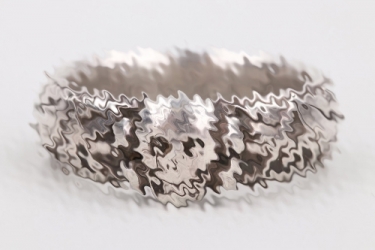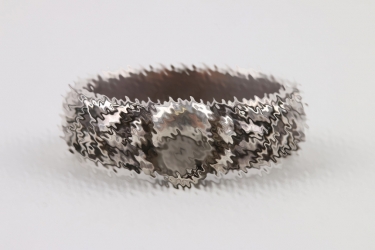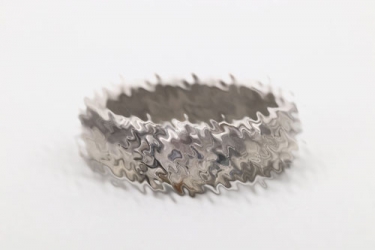SS-Ehrenring (Totenkopfring)
Militaria Preisdatenbank
Erspenmüller, Robert - SS-Ehrenring (Totenkopfring) - (30.6.34)
USD 10.011,60
Wir kaufen Einzelstücke und ganze Sammlungen und beraten Sie auch gerne telefonisch: 08541 9053699
-
Bezahlung
-
WIE KANN ICH FÜR MEINE BESTELLUNG BEZAHLEN?
AUKTIONAlle erfolgreichen Gebote werden automatisch zu einer einzigen Bestellung zusammengefasst. Für diese können Sie uns nach Auktionsende in Ihrem persönlichen Kundenkonto Ihre bevorzugte Bezahl- und Versandart oder eine alternative Lieferadresse mitteilen.
Wenn wir diese freiwilligen Angaben nicht von Ihnen erhalten melden wir uns automatisch im Laufe des Montags nach Auktionsende mit einer Zahlungsanweisung per Email. Basierend auf Erfahrungswerten schlagen wir Ihnen die bequemste Bezahlmehtode und die günstigste Versandart vor. Sie möchten Ihre Bezahl- und Versandart ändern oder eine alternative Lieferadresse angeben? Kein Problem! Besuchen Sie Kundenkonto/BESTELLUNGEN oder kontaktieren Sie uns per Email.
BESTELLUNGEN IM ONLINESHOPWählen Sie während der Bestellung Ihre bevorzugte Bezahl- und Versandart und schicken Sie diese ab. Sie erhalten Ihre Zahlungsanweisung spätestens am darauffolgenden Tag per Email. Die Zahlungsfrist beträgt sieben Tage. Sie planen eine Bestellung per Ratenzahlung zu begleichen? Bitte sprechen Sie uns gerne vor Ihrer Bestellung darauf an.
Für mehr Informationen zu Bezahlung und Versand, besuchen Sie unsere Häufigen Fragen.
WIR AKZEPTIEREN FOLGENDE BEZAHLARTEN
-
-
Versand
-
IHRE BESTELLUNG IN DEN BESTEN HÄNDEN
VERPACKUNG & SENDUNGSVERFOLGUNGNach Zahlungseingang versenden wir Ihre Bestellung für gewöhnlich am darauffolgenden Werktag. Wir bestätigen den Eingang Ihrer Zahlung per Email und informieren Sie zur Versandvorbereitung. Nach Abholung der Sendung durch unsere Versanddienstleister teilen wir Ihnen die Sendungsnummer per Email mit. Den Status Ihrer Sendung können Sie auch jederzeit unter Kundenkonto/BESTELLUNGEN einsehen. Ihre Rechnung geht Ihnen automatisch am Tag des Versands zu.
VERSAND ZU EINER ALTERNATIVEN ADRESSEBevorzugen Sie für eine Bestellung einen Versand zu Ihrer Arbeitsstelle? Sie sind im Urlaub und wünschen den Versand zu einer Packstation oder einem Freund? Kein Problem! Diese Änderungen können Sie jederzeit unter Kundenkonto/BESTELLUNGEN vornehmen. Alternativ können Sie natürlich jederzeit auch per Email informieren.
UNSERE PARTNER FÜR DEN VERSAND
-
-
Garantie
-
 GARANTIE!
GARANTIE!Alle angebotenen Artikel werden von unseren Experten akribisch auf deren Echtheit geprüft und detailiert beschrieben. Wir bieten ausschließen zeitgenössiche Originale an. Etwa 15% aller Kundeneinlieferungen ensprechen unseren Anforderungen nicht und werden retourniert.
Gekauft wie gesehen? Nicht bei uns. Im Gegensatz zu traditionellen Auktionshäusern bieten wir volles Rückgaberecht of Originalität an. Sollten Sie mit Ihrer Bestellung nicht zufrieden sein, können Sie die Bestellung innerhalb 14 Tagen widerrufen. Bitte kontaktieren Sie uns vor dem Rückversand. Für mehr Einzelheiten besuchen Sie bitte unsere häufigen Fragen.
In eigener Sache: Bieten Sie nur auf Lose, die Sie auch erwerben möchten. Bitte vermeiden Sie Gebote nach Auktionende zu stornieren. Sollten Sie ein fehlerhaftes Gebot abgegeben haben, informieren Sie uns bitte umgehend. Wir löschen Ihre Gebote gerne bis 24 Stunden vor Ende der Auktion.
-
Land Deutsches Reich 1918 - 1945
Maße
Gewicht
EAN 2000000883892
Epoche 1918 — 1945
Land Deutsches Reich 1918 - 1945
Material
Maße
Hersteller
Gewicht
Land Deutsches Reich 1918 - 1945
Los 76-1672
Maße
EAN 2000000883892
Hersteller
Gewicht
Deutsches Reich 1918 - 1945
Erspenmüller, Robert - SS-Ehrenring (Totenkopfring) - (30.6.34)
Beschreibung
This SS Honor Ring, awarded to Robert Karl Erspenmüller, represents a significant artifact from the dark history of the so-called "Third Reich". Known as the "Totenkopfring" (Death's Head Ring), it was an honor given to select SS members who demonstrated loyalty and dedication to the Nazi regime. The ring was personally awarded by Heinrich Himmler, the head of the SS, and was a symbol of both allegiance to the Nazi ideology and participation in the atrocities committed under the regime's directives.
Early Award Details
This particular ring was awarded early in Erspenmüller's SS career, on June 30, 1934. It bears the inscription:
“S. lb. Erspenmüller 30.6.34 H. Himmler”, which translates to “To my dear Erspenmüller, June 30, 1934, H. Himmler.” The ring was crafted by the jeweler Otto Gahr, who was the official manufacturer of SS honor rings.
Inner diameter: 22.35 mm.
The early date of the award places it in the immediate aftermath of the "Night of the Long Knives," a purge in which the SS played a crucial role in consolidating Nazi power by eliminating political rivals, further emphasizing the ring's connection to violent acts of repression.
Historical Context and Critical Perspective
Robert Karl Erspenmüller (*March 4, 1903, in Nuremberg; †May 23, 1940, in Blessy, France) was an SS officer deeply implicated in the crimes of the Nazi regime. In 1933, he served as the first deputy commandant of Dachau concentration camp, directly involved in the administration of the camp’s brutal system. After conflicts with the camp's leadership, including Theodor Eicke, who was tasked by Himmler with formalizing the murder of prisoners, Erspenmüller was placed on leave in July 1933. Despite this, his career within the SS continued, and in 1934 he was appointed adjutant to Franz Xaver Schwarz, the NSDAP’s Reich Treasurer, before serving in the SS-Verfügungstruppe until 1939.
Erspenmüller died during the 1940 French campaign, holding the rank of SS-Sturmbannführer, as a battalion commander of an SS unit. He was killed by a headshot in combat during an attack by French forces.
The Symbolism of the Ring
The ring stands as a powerful symbol of Erspenmüller's complicity in the Nazi system, representing his involvement in the systemic violence of the SS. As a recipient of this ring, Erspenmüller was not only a participant in the brutal concentration camp system but also someone who held the trust and favor of Heinrich Himmler. The ring's craftsmanship by Otto Gahr further ties it to the elite circles of the SS leadership.
Critically, the SS Honor Ring is a reminder of the dark role Erspenmüller played in upholding a regime responsible for mass atrocities, including the murder of millions. The possession of this ring is not only a mark of personal loyalty but also of active participation in a genocidal regime, whose legacy is one of unimaginable suffering.
Zustand
2





















